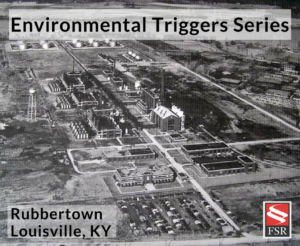FSR recently reached out to members of our online community to ask if they felt that poor air quality, industrial pollution, or any other environmental triggers have caused a flare up or even the development of their sarcoidosis. The post generated an overwhelming number of responses, as well as productive discussion on genetics, environment, and other potential disease contributors.
Based on these responses, we decided to do a blog series on a few of the diverse stories that we came across. These stories represent the wide variety of toxins and environmental factors that have caused patients daily problems, as well as those that patients suspect contributed to their disease in the first place.
Below is the first part of our series: Growing Up in Rubbertown
When Darleen Rusnak was a young girl, her family moved to a neighborhood of Louisville, Kentucky called Rubbertown. The town sits along the Ohio River and at the time it was home to dozens of industrial sites that manufactured products including acrylic plastics, formaldehyde, vinyl fluoride, Freon, and various types of rubber. Many of the materials or waste byproducts are now recognized as carcinogens. One of the many industrial sites in the area was the DuPont plant, known for its fatal explosions in August, 1965 that killed 12 workers and injured 37 more.
“From the ages of 6-10 we lived on Bramers Lane, which had some of the air pollution from DuPont, Union Carbide, Stauffers Chemical Company, and oil refineries. When I was 11 years old, we moved to Lake Dreamland which was in closer proximity to the chemical plants and their dumps. We were evacuated on more than one occasion for chemical leaks at DuPont. Most of the time it was from ammonia. Men would come to the door in the middle of the night, with gas masks on, and tell us we would have to leave… there would be a haze about a foot above the ground and it would gag you with the smell.”
Despite the obviously dangerous fumes in the air, Darleen noted that there was never any news coverage on the evacuations of the local residents. The young children of the neighborhood were repeatedly exposed to these conditions without any preventative measures like gas masks.
“In the fifties, children played outside all day, so our exposure was great and we also had no air conditioning. My older brothers and I would sneak into DuPont’s dump which was at the end of our street, 150 to 200 feet from our house. There were spontaneous fires in the dump that we would watch at night. There was a huge pipe that burned night and day.”
Darleen has neurosarcoidosis, with permanent facial paralysis on the right side of her face. Darleen’s younger sister also has sarcoidosis in her lungs, breasts, and eyes. Both sisters suffer from a multitude of other symptoms from their sarcoidosis. Their two older brothers have never been tested for sarc, but the eldest has COPD.
“There is no doubt that all the toxic exposure that we got caused the illnesses that we have. My sister had bronchial asthma as a child and she and I had many upper respiratory illnesses as children. My brother and I often discuss the fact that most of the people that grew up in this area are now deceased.”
Darleen’s family moved away from the area when she was 15, so her exposure to these particular toxins was limited to her childhood. One of her friends is a Biology professor at the University of Louisville who has spent years studying this region of Kentucky and the health problems of those who lived there. Today, there are still at least 11 major chemical plants in the neighborhood where Darleen grew up and with them, countless more stories of chemical leaks, industrial accidents, and loosely-enforced policies on waste dump sites.

